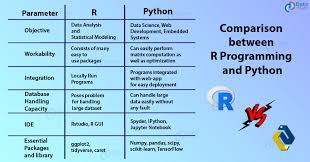The Power of ‘r’ in Python
Python is a versatile and powerful programming language known for its simplicity and readability. One of the features that make Python so flexible is the ‘r’ prefix that can be applied to strings.
When you add an ‘r’ before a string in Python, it denotes a raw string literal. This means that the backslashes within the string are treated as literal characters and are not used to escape characters. This can be particularly useful when working with file paths, regular expressions, or any other string where backslashes are commonly used.
For example, if you have a file path like “C:\Users\John\Desktop\file.txt” and you want to use it in your Python code, you can either double up the backslashes like “C:\\Users\\John\\Desktop\\file.txt” or simply prefix the string with an ‘r’ like r”C:\Users\John\Desktop\file.txt”. The latter option is cleaner and easier to read.
Raw strings are also handy when dealing with regular expressions. Since regular expressions often contain many backslashes to escape special characters, using raw strings can simplify your regex patterns and make them more readable.
In conclusion, the ‘r’ prefix in Python provides a convenient way to handle strings without worrying about escaping special characters. It’s a small but powerful feature that can make your code cleaner and more maintainable.
Understanding the ‘r’ Format and Usage in Python: Files, Strings, and RegEx
- What is the r format in Python?
- How to escape \r in Python?
- What is r in Python files?
- What is r in RegEx Python?
What is the r format in Python?
The ‘r’ format in Python, also known as a raw string literal, is a special prefix that can be applied to strings. When ‘r’ is added before a string, it indicates that the string should be treated as a raw string, where backslashes are interpreted as literal characters rather than escape characters. This feature is particularly useful when working with file paths, regular expressions, or any strings that contain backslashes. By using the ‘r’ format in Python, developers can simplify their code and improve readability by avoiding the need to double up backslashes or worry about escaping special characters within the string.
How to escape \r in Python?
One frequently asked question in Python programming is how to escape the ‘\r’ character. In Python, ‘\r’ represents a carriage return character, which moves the cursor to the beginning of the current line without advancing to the next line. To escape the ‘\r’ character in Python strings, you can use a raw string literal by prefixing the string with ‘r’. This ensures that backslashes are treated as literal characters and not used for escaping. By using raw strings, you can handle ‘\r’ and other special characters effectively in your Python code.
What is r in Python files?
The ‘r’ prefix in Python files denotes a raw string literal. When used before a string, it indicates that the backslashes within the string should be treated as literal characters and not used for escaping other characters. This feature is particularly useful when working with file paths or regular expressions, where backslashes are commonly used. By using ‘r’ in Python files, developers can ensure that the specified paths or patterns are interpreted exactly as they are written, making code cleaner and more readable.
What is r in RegEx Python?
In the context of regular expressions in Python, the ‘r’ preceding a string denotes a raw string literal. When using regular expressions, the ‘r’ is commonly used to create raw strings that treat backslashes as literal characters rather than escape characters. This is particularly useful when working with regex patterns that contain special characters requiring backslashes for escaping. By using ‘r’ in RegEx Python, developers can simplify their regular expression patterns and enhance code readability by avoiding the need to double up on backslashes for escaping purposes.

